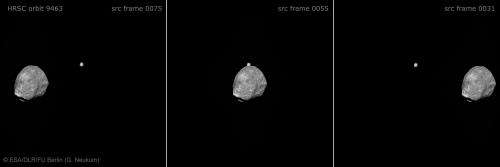Credit: ESA/DLR/FU Berlin (G. Neukum)
(Phys.org) —Even though it may only be a lump of porous rock, Phobos isn't shy about hogging the limelight in this sequence taken by ESA's Mars Express. These three images show Phobos, the larger of the two martian moons, darting across the frame in front of Jupiter, visible as the pale dot in the centre. From right to left, the frames show snapshots before, during and after the small moon's journey in front of the gas giant.
Observed on 1 June 2011, this unusual alignment is known as a conjunction, and occurs when two Solar System bodies appear to pass close to one another on the sky. This is an optical illusion caused by our perspective–when these pictures were taken there was a distance of almost 11 400 km between the spacecraft and Phobos, and a further 529 million km to Jupiter.
These three frames are part of a set of 104 taken over a period of 68 seconds by the high-resolution stereo camera on Mars Express. Some of the images were also processed to form a video. The images and the video were originally released in June 2011.
Provided by European Space Agency
























